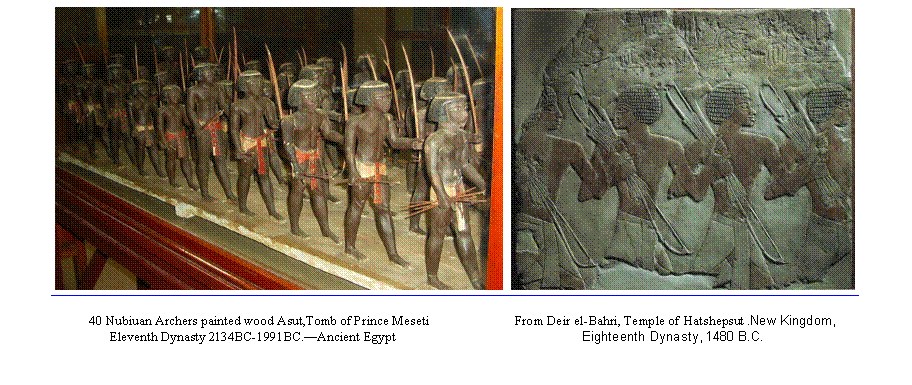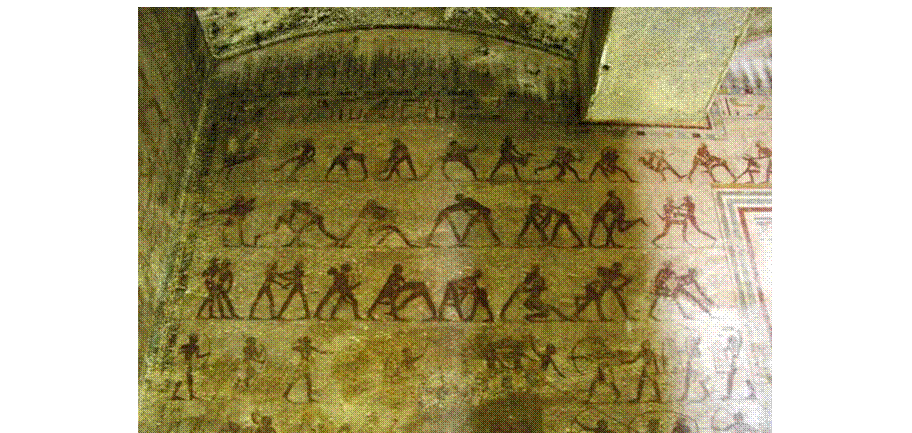|
KEMETIC TEMPLE Ancient Kemet
Nuba fighting
Nuba fighting is done by people of the Kurdufan hill country of central Sudan, involving both stick fighting and wrestling.
NUBA WSTESTLING SUDAN
Techniques
The goal of Nuba Wrestling is to slam the opponent to the ground. Wrestling is relatively recreational, and serious injuries are rare. Nuba wrestling has no pinning and no submissions. Although there are strikes, these are essentially part of the grappling; in other words, this is not a boxing system, as is, for example, Hausa dambe. Therefore, Nuba wrestling is best viewed as a system of standing grappling, historically practiced naked, but in towns, today practiced in T-shirts and shorts. Nuba stick fighting essentially mimics the movements of fighting with spear and shield. Little armor is worn, so injuries can be severe.
Training
Training for both wrestling and stick fighting includes practicing under the supervision of former champions, performing athletic dances, learning traditional songs, and drinking lots of milk while avoiding promiscuity and beer.
Tournaments
Nuba wrestling tournaments are associated with planting and harvest festivals. The purpose of the wrestling at these festivals is to build group identity and display the prowess of the group's young men. (At Nuba wrestling matches, youths represent their villages rather than themselves.) Nuba stick fighting tournaments usually take place after harvest. This is partly because this is the traditional war season, and partly to give thanks for a good harvest. Because stick fighting is dangerous, participants pray before bouts, and amulets may be worn for protection. If a participant is seriously injured, then he or his family are supposed to be compensated by the other village, usually in the form of a cow or similar valuable commodity. During wrestling and stick fighting tournaments, feasts, music, dance, and stories about former champions are integral to the practice. Although stick fighting tournaments are not usually seen in modern cities (police take a dim view of crowds of armed young men roaming the streets), wrestling tournaments are often used by people living in those same cities to help them retain their sense of cultural identity.
NUBU WRESTLERS KEMET
Contentious areas
There are frescoes showing wrestlers and stick fighters in the temples at Beni Hasan, in Egypt. These temples date to about 1950 BCE. Some of wrestlers and stick fighters shown in these frescoes are black, and some of the techniques shown in the illustrations can be seen in Nuba stick fighting and wrestling. See, for example, Carroll, cited below. If the people who currently live in Kurdufan share the same culture as the people who live in Kurdufan today, then there could be a relationship between modern Nuba wrestling and ancient Egyptian wrestling. Cautions here include the following: 1) Pictures of wrestling and stick fighting tend to look alike, no matter who is in them. 2) The people who live in Kurdufan now may have moved there more recently than 4000 years ago. If so, who influenced whom? 3) The Nuba are not noble savages. Instead, they are people whose culture, like all cultures, has changed over time.
It has been thought that Nuba learned techniques for wrestling and/or stick fighting from watching animals play. Many warrior societies have stories attributing the development of their martial arts to warriors getting ideas after having watched birds, insects, or animals fight. Whether such stories are literally true is not as important as whether subsequent practitioners repeat them. If they do, then such stories become integral parts of the shared values that distinguish groups, communities, and cultures.
|






